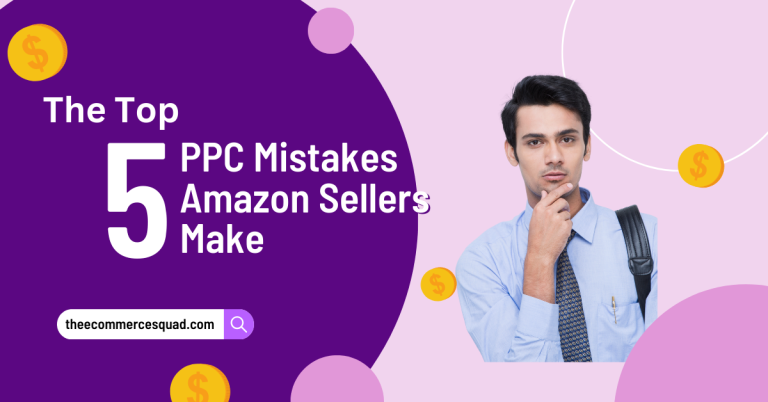The Top 5 Sourcing Mistakes Amazon Sellers Make (And How to Avoid Them)
Sourcing the right products is critical to the success of your Amazon business. However, even experienced sellers can fall into common traps when sourcing products, which can lead to poor profit margins, quality issues, or long delays. Avoiding these mistakes can help you secure better deals, maintain quality control, and ensure your products reach customers smoothly.
In this blog, we’ll cover the top 5 sourcing mistakes Amazon sellers make and how you can avoid them to ensure your business remains profitable and scalable.

1. Not Vetting Suppliers Thoroughly
Mistake: One of the biggest mistakes sellers make is jumping into business with a supplier without proper vetting. Failing to check a supplier’s reliability, product quality, or business practices can lead to delays, subpar products, or even scams.
How to Avoid It:
Take the time to vet your suppliers before placing any orders. Use platforms like Alibaba or other supplier directories, but always:
- Check supplier reviews and ratings.
- Ask for product samples to assess quality.
- Request certifications or documentation that proves the supplier’s legitimacy and compliance.
- Schedule a video call or, if possible, arrange for a third-party inspection.
- Building relationships with trustworthy suppliers minimizes risks and ensures that you’re sourcing high-quality products that meet Amazon’s standards.
2. Overlooking Product Quality for Price
Mistake: Many sellers focus solely on price when sourcing products, often sacrificing quality in the process. A lower-cost product may seem appealing at first, but poor quality can lead to negative reviews, high return rates, and ultimately, a damaged seller reputation.
How to Avoid It:
Instead of looking for the cheapest supplier, prioritize quality over price. Request samples from multiple suppliers and compare not just the cost but the quality of the materials, craftsmanship, and packaging. Always remember that your brand’s reputation is directly tied to the quality of your product.
Use the profit margin calculator tools from Sellics to calculate how much you can afford to spend on a quality product while still maintaining a healthy profit margin. In the long run, investing in better quality leads to more satisfied customers and fewer returns.
3. Not Considering Shipping and Lead Times
Mistake: Ignoring shipping logistics can be a costly error. Many sellers fail to factor in lead times or unforeseen delays that can disrupt inventory flow and lead to stockouts, especially if sourcing internationally.
How to Avoid It:
Always account for shipping time and logistics when planning your sourcing strategy. Consider the following:
- Lead Times: Know the production time of your supplier and how long it will take to manufacture your products.
- Shipping Options: Understand whether you’ll be using air or sea freight and how that affects delivery timelines and costs.
- Buffer Stock: Always keep extra stock on hand to cover any unexpected delays in shipment.
- By planning ahead and staying informed about lead times, you avoid stockouts and ensure that your products remain available for purchase, even during high-demand periods.
4. Ignoring Legal and Compliance Issues
Mistake: Some sellers fail to comply with Amazon’s strict regulations or legal requirements for selling specific products. This mistake can lead to account suspension, product removal, or even legal action.
How to Avoid It:
Make sure you’re fully aware of legal and compliance regulations in the region you’re selling. Common compliance issues include:
- Certifications: Some products (like electronics, food, or cosmetics) require safety or quality certifications. Check your product category for any mandatory certifications.
- Intellectual Property: Ensure your product doesn’t infringe on trademarks, patents, or copyrights.
- Labeling Requirements: Follow Amazon’s guidelines on labeling, packaging, and safety warnings.
- Getting these things right from the beginning will help you avoid costly penalties, product bans, or worse—account suspension.
5. Not Negotiating Terms and Prices
Mistake: Many sellers accept the first price they’re offered, missing out on better deals or more favorable payment terms. Failing to negotiate can impact your profit margins significantly.
How to Avoid It:
Negotiation is key to maximizing profit. Whether you’re working with a domestic or international supplier, don’t hesitate to negotiate better terms, such as:
- Lower Prices: Suppliers often have some room to offer discounts, especially if you’re buying in bulk.
- Payment Terms: Request staggered payment options like 30% upfront and 70% after production.
- Shipping Fees: Ask your supplier if they can contribute to shipping costs, especially for large orders.
- By negotiating, you improve your margins and maintain healthy cash flow, setting your business up for long-term success.
Conclusion
Sourcing products for Amazon can be a complex process, but by avoiding these common mistakes, you can improve your profitability and build a more sustainable business. Always vet your suppliers, prioritize quality, consider shipping logistics, stay compliant, and negotiate for better terms.







